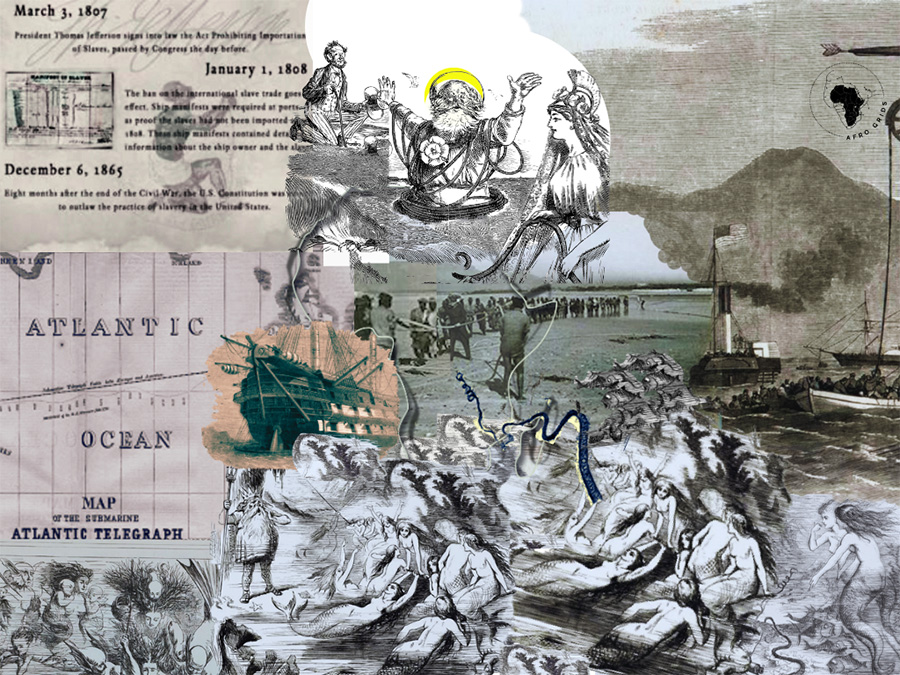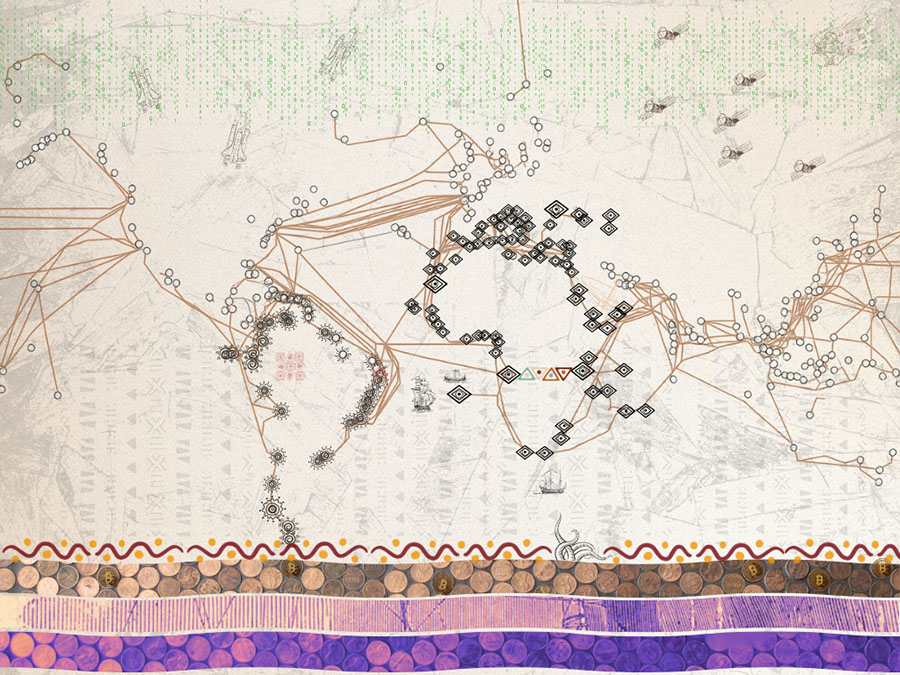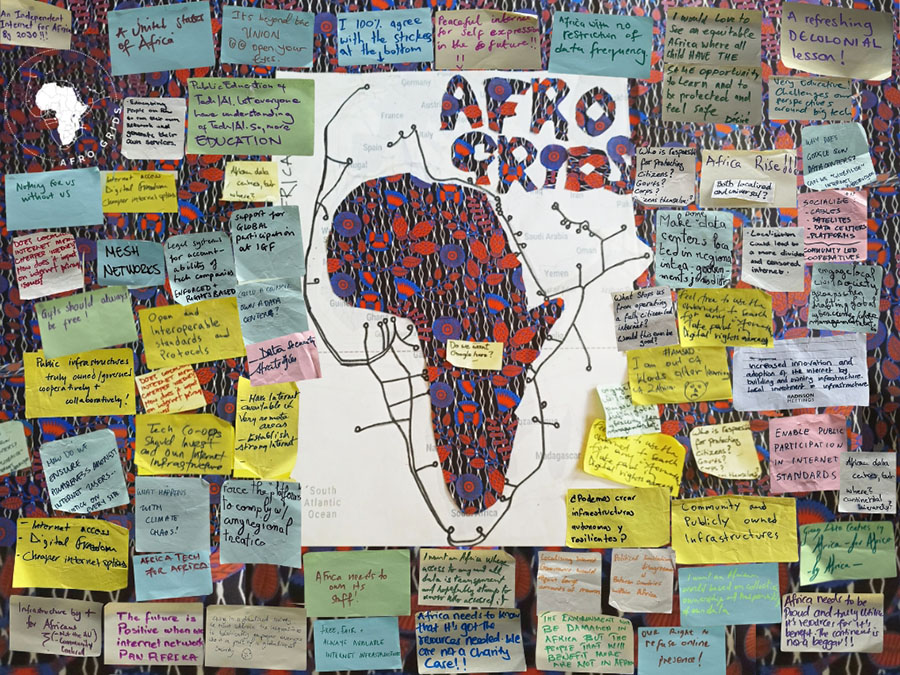“One day, when the sky is burdened with tech waste, so we are blind to tell the difference between cosmic bodies, we will look up on a clear night and make a wish upon a burning decommissioned satellite.”
Esther Mwema, Cosmology of Internet Infrastructure
The cosmos is changing. In 2024, deep in the forests of Zambia, I turned my gaze toward the glittering night sky. I was excited to spot moving constellations immediately; one after the other, they trotted in a single file along the pitch-black sky. The popular myth that the internet is in the cloud is almost like a prophecy with the emergence of low Earth orbiting satellites. What I witnessed that night was a fleet of Starlink satellites. The truth is, at least 95 percent of our internet currently travels through the ocean. And yet, for something so grounded, we are increasingly witnessing a push toward the stars. This all seems disjointed, and yet internet infrastructure has now become central to how we view ourselves and the universe.
Through the Green Screen Catalyst Fund Award, sponsored by the Mozilla Foundation, I collaborated with three practitioners working toward digital equity, from diverse backgrounds and geographies. The goal was to understand hidden systems of power, the rhetoric that conceals these systems, and how our imagination can uproot the seeds of oppression planted within our infrastructure.
The Cosmology of Internet Infrastructure features my art research, and essay contributions from Elinor Arden, Emsie Erastus, and Raymundo Vásquez Ruiz. This article highlights a summary of these different cosmologies, with the intent of uncovering the way internet infrastructure has shaped and still is shaping our cosmology. Earlier this year, I gave a keynote at Re:publica to surmise this layered perspective on internet infrastructure.
What in the cosmology?
The Cosmology of Internet Infrastructure investigates the stories we tell ourselves about the origins of the internet and how this is manifesting in our space-time reality. The measure of time-space shifted during the colonial era, enforced with the Atlantic telegraph commissioned soon after the abolition of the Atlantic slave trade. The telegraph gave birth, geopolitically and culturally, to undersea cables which have wrought the information age, through the internet.
Now the inventor of the Internet Protocol, Vint Cerf, is leading groundbreaking research on interplanetary internet networks. This is an era where tech billionaires are comparing the size of their rockets to see who can be in space faster and for longer. There is also a galactic gold rush, with attempts to mine the moon for minerals, and efforts to decarbonize emerging technologies like AI have fueled interest in the space tech industry and geospatial intelligence. The fabric of the universe, from outer space to the Earth’s mantle and deep seas, is now entangled with internet infrastructure.
Often, we separate the internet from the context within which we exist, that is, the natural world. Examining internet infrastructure through the lens of cosmology allows for a holistic perspective on the impact of this technology on how we perceive ourselves as people in an increasingly digital world. This offers a critical view of our past-present cosmology, the shift toward greening the internet as a transitory cosmology, toward a future cosmology of liberated peoples on Earth or in space.
Past-present cosmology: Empire’s nervous system

In the first chapter of the Cosmology of Internet Infrastructure, Elinor Arden writes about finding records showing telegraph maps from the 18th century in the British National Archives. These maps are near-identical to the maps of undersea cable networks owned by big tech corporations today. The similarities do not end there, showing how the past mirrors the present. Arden writes:
“While the transport of matter across the Atlantic was regulated by the undersea telegraph network, the network also regulated human bodies in the service of the imperial government. Undersea telegraph cables were a tool for policing and disciplining colonized subjects and laborers, since governors across the Empire could communicate instantaneously as soon as resistance broke out…
If the cable network was built as the Empire’s sensorium, it was used to control the bodies bound to the Empire: its flesh and blood. In turn, these bodies were forced to plunder the earth-as-body in mines and plantations.”
The Atlantic telegraph was the Empire’s nervous system. Nowadays, the layers of the internet are increasingly owned by Big Tech companies who continue to benefit from the colonial legacy of their nation states to exploit minerals and data from formerly colonized lands. This time, they present themselves as saviors by greenwashing these energy-intensive infrastructures.
Transitory cosmology: sacrifice zones

In the second chapter, Raymundo Vásquez Ruiz points out competing ideologies toward bridging the digital divide. He challenges the mainstream Westernized framing of the climate crisis as a technical problem rather than a socio-economic and political one. He points out how being ‘green’ is now a marketing tool that conceals the true cost of the technology, with the primary goal of these corporations being maximized profits for themselves and their investors, so as to acquire more power at global scale. This, he writes, excludes local communities from decision-making processes in issues related to their territory. Ruiz cautions:
“We need to abandon the myth of infinite growth. The latter is physically impossible and contributes directly to environmental destruction. Instead, we need to focus our efforts on the communities’ needs to create new technologies only when they are truly necessary… This way of life favors plurality, reciprocity, complementarity, and care. It functions through decision-making processes through assemblies, where participation from the entire community is requested, ensuring no voice is left out. It forges authorities that emerge from dedication to communal work, and their roles are in constant rotation to avoid creating hierarchies. This way of living has allowed indigenous communities to survive the colonial genocides and resist matricide (killing our Mother Earth).”
Big tech corporations are investing billions toward internet infrastructure. Infrastructure models that center community over profit are pushed to the margins. Now, these corporations are using these systems to develop artificial intelligence that is already shifting our digital ecosystem. The future is on the precipice.
Future cosmology: earthseed

In the third chapter, Emsie Erastus presents a manifesto that can serve as a beacon for Africa’s exodus from digital oppression. This exodus is centered on creating a ‘third way’ that provides an alternative path based on a genuine and non-mediated human experience. This would resist, she writes, that dominant technological architectures concentrate choice in the hands of a few, excluding local voices and entrenching existing power differentials. Erastus sheds light on the religion of Big Tech:
“Communities…have unwittingly embraced the ‘church of Big Tech,’ where the pillars of AI and technological innovation are worshipped as the answer to society’s problems. This form of idolatry risks transforming faith into a tool for advancing the agenda of elite groups, who exploit religious narratives to legitimize their control.
Big Tech preachers like Elon Musk have positioned themselves as cultural Christians, leveraging religious rhetoric to gain support from conservative Christians while simultaneously promoting an agenda that prioritizes technological colonization, whether through AI, space exploration, or digital surveillance.
This paradoxical relationship sheds light on how Big Tech has been able to weaponize religious narratives to create a facade of moral legitimacy, making it appear like Big Tech was ‘doing the right thing’ and forcing communities to accept its narrative, without questioning the morality of its implications.”
The future of technology intertwines emerging technology with the ideological beliefs of the people who own the internet infrastructure through which this technology is being incubated. This puts our future and that of the planet at the risk of technological determinism from the elite few that are enriching themselves whilst creating poverty for the rest of the world. We must resist!
Collective visions of African internet infrastructure

We are at a critical stage, a transitory cosmology, where our technological future is still being morphed. Big Tech bros have big dreams for themselves and their machines. The Cosmology of Internet Infrastructure shows us we are living in the imagination from the 1700s. Our imagination today can fuel a more equal, ethical, and healthy planet tomorrow. The infrastructure we invest in today, the beliefs we hold about how digital systems work and whom they serve, is actively forming the future cosmology we will live in.
As the cosmos shifts, in 2025, I watch the Zambian sky glow brilliantly at night during the year-long ongoing power cuts incited by a recent drought. In the same universe, foreign investors use Zambian hydroelectricity to power their lucrative bitcoin mine with constant cheap renewable electricity, while positing themselves as saviors of the rural community they’ve inhabited. Internet infrastructure, hidden, becomes the system of power.
Ultimately, the Cosmology of Internet Infrastructure allows us to uncover the Empire’s nervous system, challenge the creation of sacrifice zones through greenwashing emerging technologies, and tear down the altars of Big Tech in an exodus from digital oppression.
To me, the future cosmology can be one where internet infrastructure becomes a tool that supports a human-centric universe where, as Paulo Freire suggests, there is neither oppressor nor oppressed.
Read the full Cosmology of Internet Infrastructure
Cosmology-of-Internet-Infrastructure_Three-visions-for-bridging-the-digital-divide-by-Esther-Mwema-with-Elinor-Arden-Emsie-Erastus-Raymundo-Vasquez-Ruiz-minEsther Mwema is an award-winning artist and digital inequalities expert from Zambia, working on issues around internet governance, internet infrastructure, and internet freedom. Esther’s practice intersects art and tech-innovation, interrogating hidden systems of power in digital society ranging from fiber optic cables, digital colonialism, to gender inequality.
Esther has over 10 years commitment to social impact at the grassroots via her nonprofits Digital Grassroots and Safety First for Girls (SAFIGI) Foundation; Esther has also done extensive work within the UN system. Esther is an Open Internet for Democracy leader who centers African feminist and decolonial methodologies in practice. She is a recipient of the Green Screen Coalition Catalyst Fund Award.
